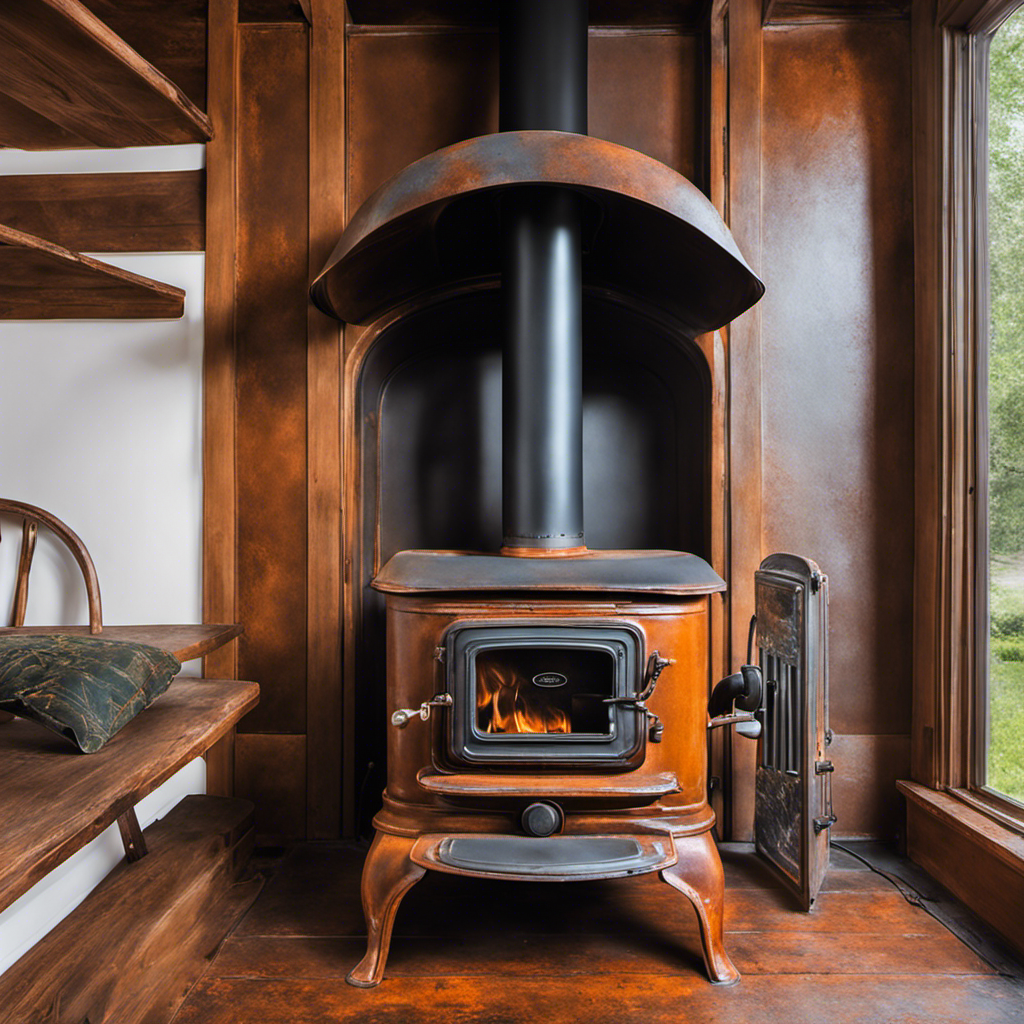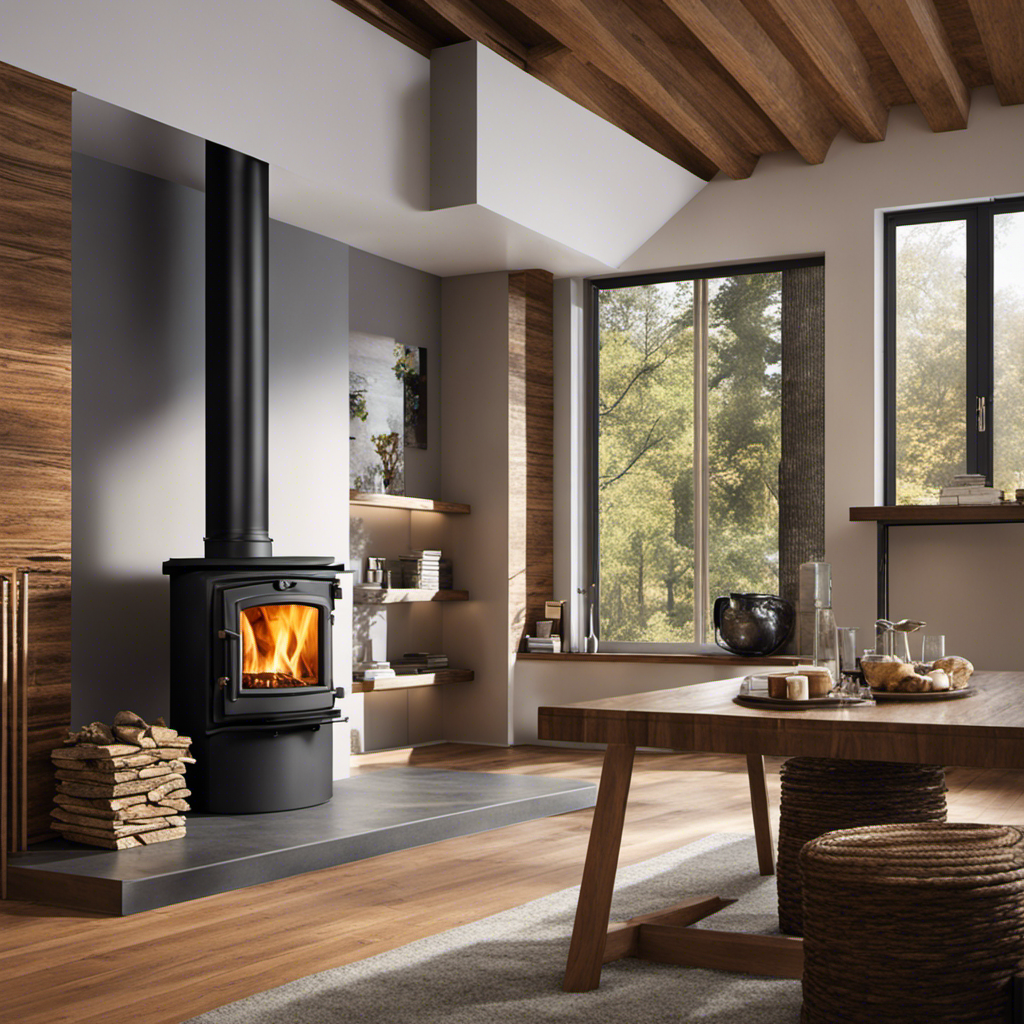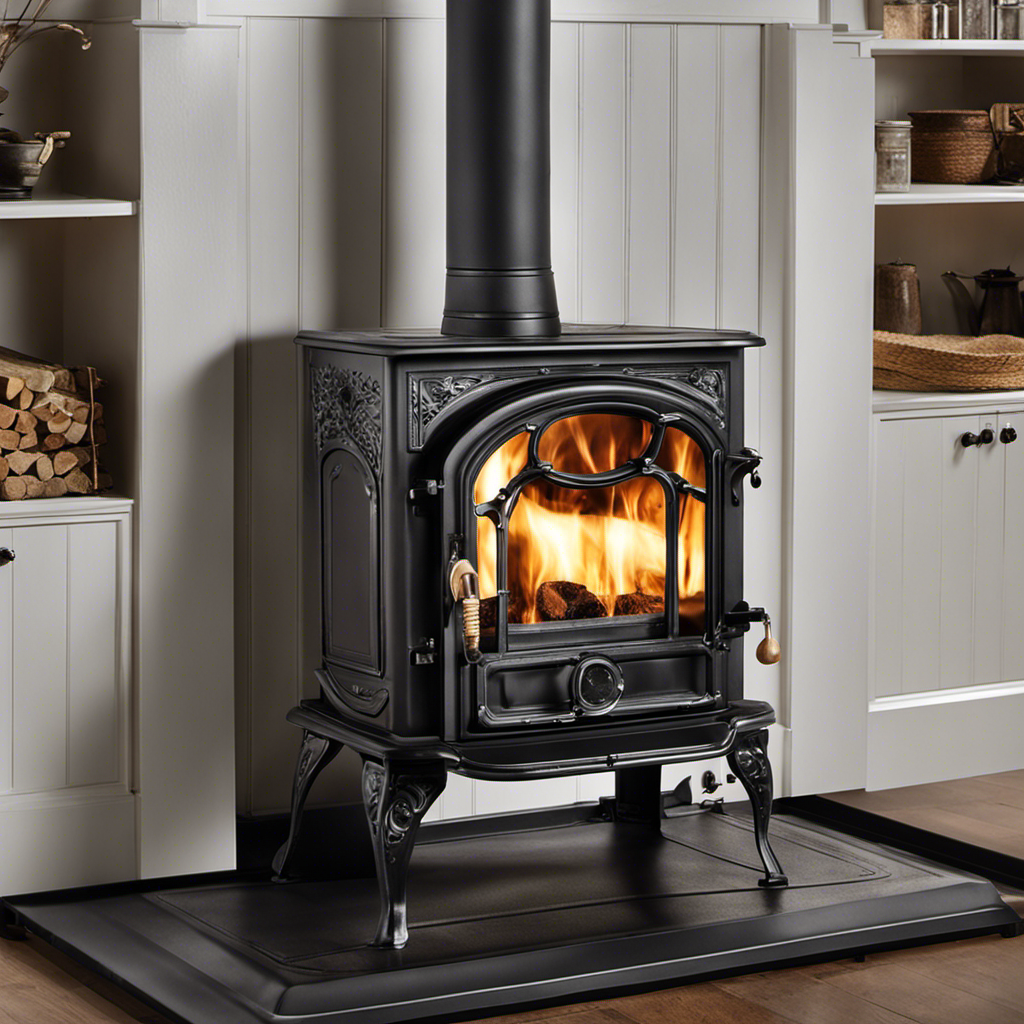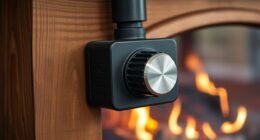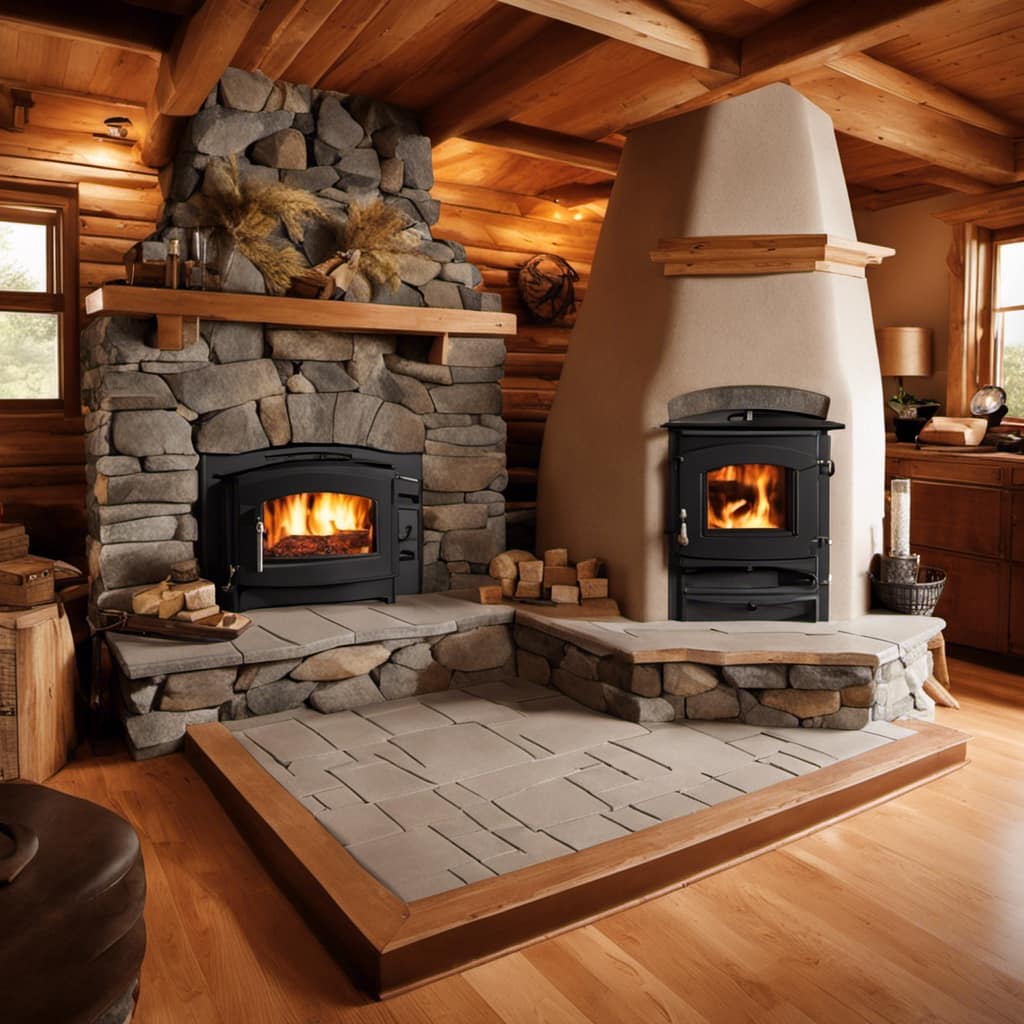
I have found the key to maintaining a wood stove burning throughout the night. It is not solely dependent on the type of firewood or the specific model of the stove – rather, it is the culmination of various factors that result in a consistent and effective burn.
In this article, I’ll share my knowledge and experience on properly seasoning firewood, maximizing airflow, and managing dampers and air controls. Follow these tips and you’ll never wake up to a cold stove again.
Key Takeaways
- Properly season firewood to ensure efficient and long-lasting burning.
- Control airflow by adjusting the damper and using air vents effectively.
- Use high-quality insulation materials and sealing techniques to prevent heat loss.
- Regularly clean and maintain the wood stove for optimal performance and safety.
Properly Seasoned Firewood
I make sure to use properly seasoned firewood to keep my wood stove burning all night. Properly seasoned firewood is essential for efficient and long-lasting burning. The key is to ensure that the firewood has a low moisture content.
Moisture content refers to the amount of water present in the wood. Green or freshly cut wood typically has a high moisture content, which can hinder combustion and create excessive smoke.
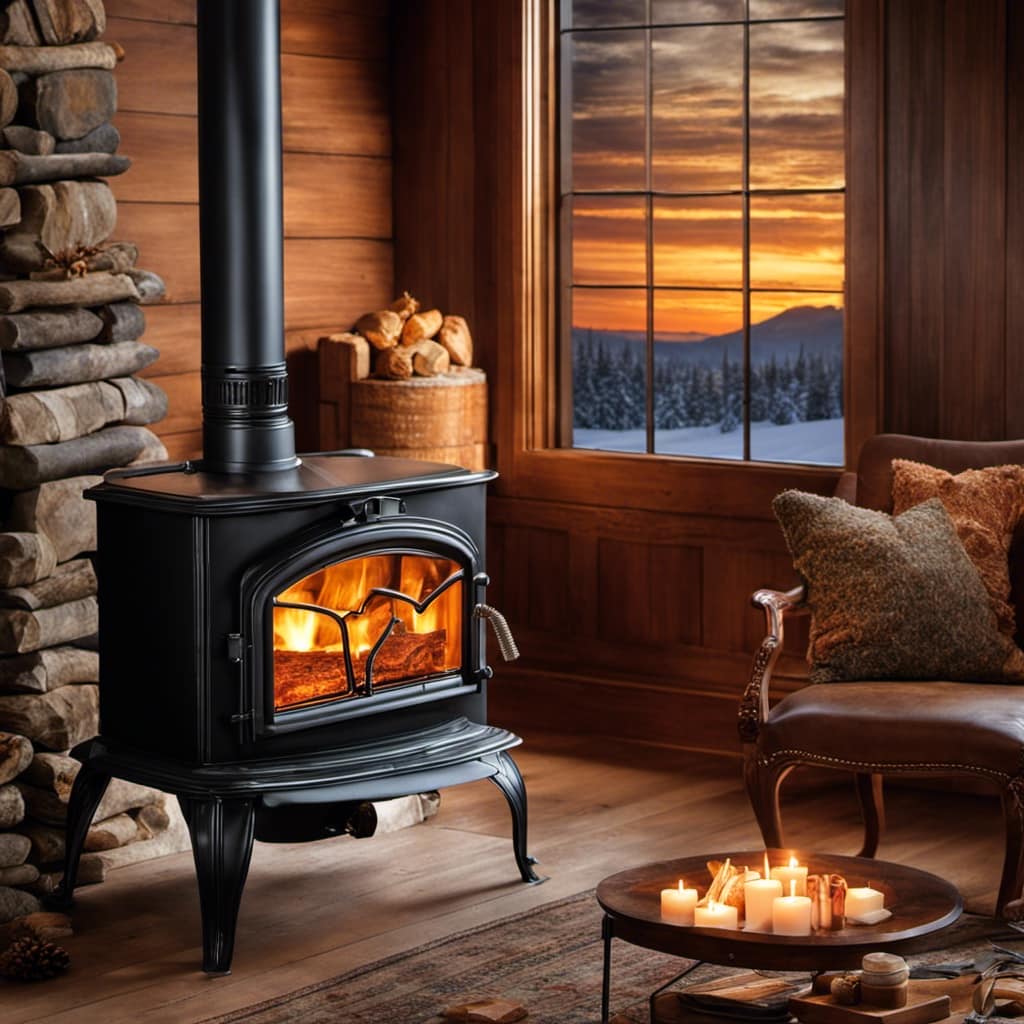
To properly season firewood, it should be stored in a dry and well-ventilated area for at least six months to a year. This allows the wood to dry out and reach a moisture content of around 20%. I store my firewood in a covered woodshed, elevated off the ground to prevent moisture absorption from the soil. It’s important to stack the firewood loosely, allowing air circulation between the logs. This promotes faster drying and reduces the risk of mold or rot.
Building a Long-Lasting Fire
Building a long-lasting fire requires careful attention to detail and proper technique. First, selecting the right type of wood is crucial, as dry hardwoods like oak and hickory burn longer and produce more heat.
Second, controlling the airflow is essential to maintaining a steady and consistent burn. Adjusting the damper and using the air vents effectively will help regulate the temperature and prevent the fire from burning too quickly.
Lastly, ensuring proper insulation and sealing around the fireplace or wood stove will minimize heat loss and maximize the efficiency of the fire, allowing it to burn for an extended period of time.
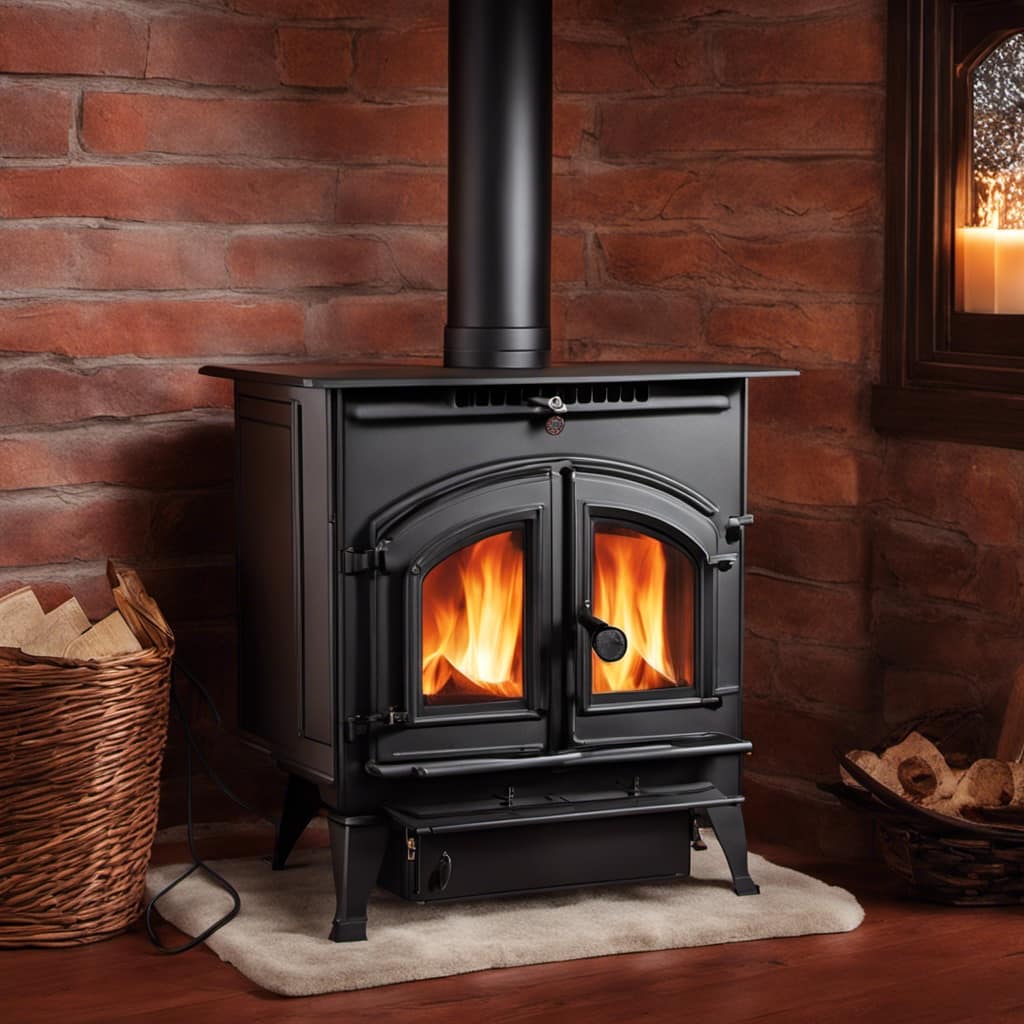
Proper Wood Selection
To keep a wood stove burning all night, it’s important to choose the right type of wood. The wood you select should be properly seasoned and have a low moisture content. Wet or green wood won’t burn efficiently and can cause excessive smoke and creosote buildup in the stove.
Here are some key factors to consider when selecting firewood:
-
Wood storage: Properly store your firewood in a dry and well-ventilated area. This will help reduce moisture content and ensure the wood burns efficiently.
-
Firewood moisture: Aim for a moisture content of around 20% or less. You can use a moisture meter to check the moisture level of the wood before burning.
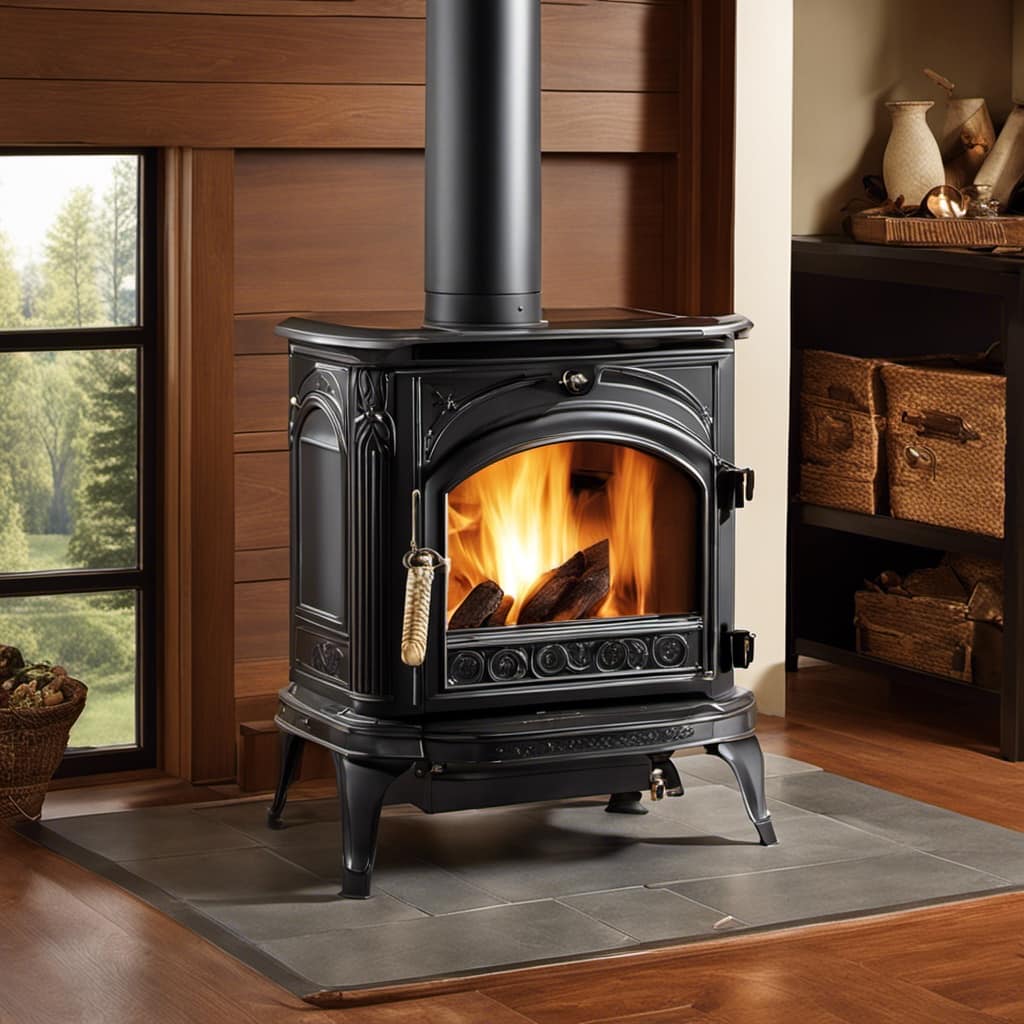
-
Hardwood vs. softwood: Hardwoods like oak and maple burn longer and produce more heat compared to softwoods like pine and spruce.
-
Wood size: Cut the firewood into small to medium-sized pieces for better airflow and more even burning.
By choosing the right type of wood and properly storing it, you can optimize the burning efficiency of your wood stove.
Now, let’s explore some airflow control techniques to further enhance the performance of your stove.

Airflow Control Techniques
Using the airflow control techniques, I can easily adjust the amount of oxygen entering the wood stove to regulate the burn rate and maintain optimal heat output. By manipulating the air vents, I can increase or decrease the airflow, which directly affects the combustion process.
To achieve a longer burn time, I typically close the primary air intake slightly to restrict the oxygen supply. This slows down the burn rate and extends the duration of the fire. However, it’s important to find the right balance because too little air can lead to incomplete combustion and excess smoke.
Regular stove maintenance is crucial to ensure proper airflow adjustments. This includes cleaning the air vents and removing any obstructions that may hinder the airflow. With these techniques, I can maximize the burn time of my wood stove and enjoy a cozy, warm atmosphere throughout the night.
Insulation and Sealing
With proper insulation and sealing, I can ensure that the heat produced by my wood stove stays inside and keeps my home warm throughout the night. Insulating and sealing techniques are crucial for maximizing the efficiency of a wood stove and preventing heat loss.
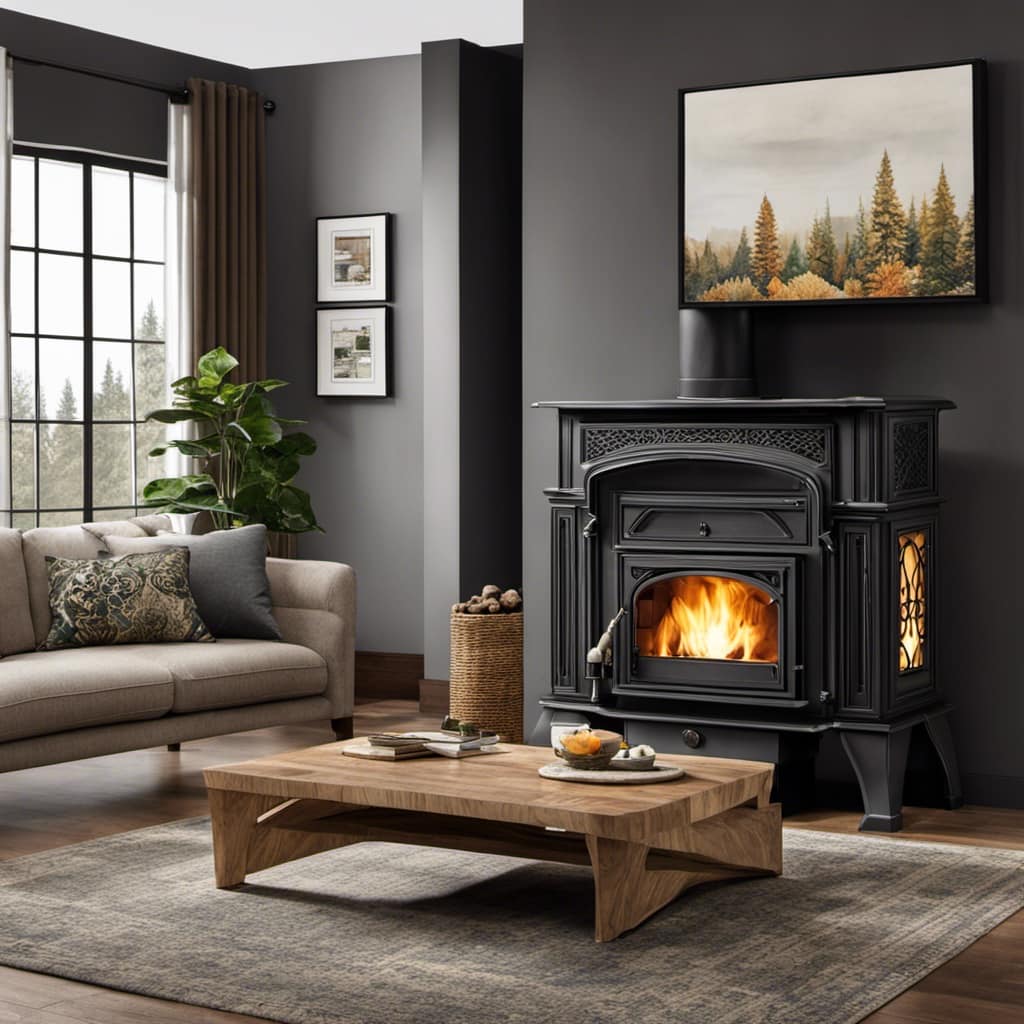
Here are four key methods to consider:
-
Use high-quality insulation materials such as mineral wool or fiberglass to wrap around the chimney and stove pipes. This prevents heat from escaping through the walls and directs it into the living space.
-
Seal any gaps or cracks around windows, doors, and vents using weatherstripping or caulking. This prevents cold air from entering and warm air from escaping.
-
Install a heat-resistant glass door on the wood stove. This not only adds a layer of insulation but also allows you to monitor the fire and adjust airflow without opening the stove door.
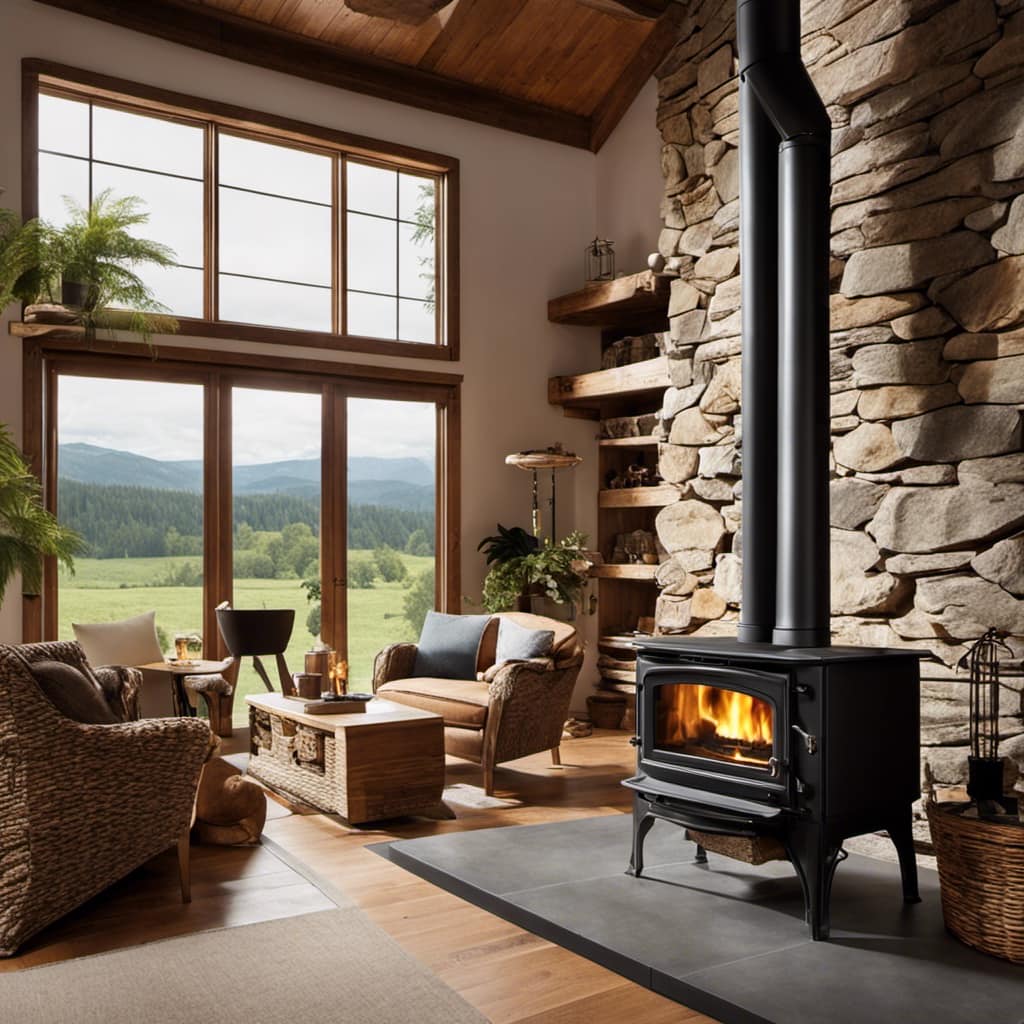
-
Consider insulating the floor and ceiling in the area where the wood stove is located. This helps retain heat within the room and prevents it from escaping to other parts of the house.
Using the Right Wood Stove
I find that the right wood stove makes a big difference in keeping the fire burning all night. When it comes to building a fire, the efficiency of the wood stove plays a crucial role. A well-designed wood stove ensures that the fire burns steadily and efficiently, allowing for longer burn times without constant refueling.
To achieve optimal wood stove efficiency, it’s essential to consider a few key factors. First, the size of the stove should match the space it will be heating. A stove that’s too small may struggle to generate enough heat, while a stove that’s too large can lead to inefficient burning and wasted energy.
Additionally, the design of the wood stove can greatly impact its efficiency. Look for stoves with features like secondary combustion, which allows for more complete burning of the wood and reduces the amount of smoke and pollutants released into the air.

Furthermore, efficient air control is crucial for maintaining a long-lasting fire. Stoves equipped with adjustable air vents or dampers allow you to regulate the airflow, helping to control the burn rate and maximize heat output. By adjusting the air intake, you can achieve a steady burn throughout the night.
In conclusion, choosing the right wood stove is essential for maintaining a long-lasting fire. By considering factors such as size, design, and air control, you can ensure optimal wood stove efficiency and enjoy a comfortably warm space throughout the night.
Now, let’s explore the next step in maximizing airflow for efficient burning.
Maximizing Airflow for Efficient Burning
When it comes to maximizing airflow for efficient burning in a wood stove, there are a few heating efficiency tips that can help prevent smoke buildup. Here are four key strategies to consider:
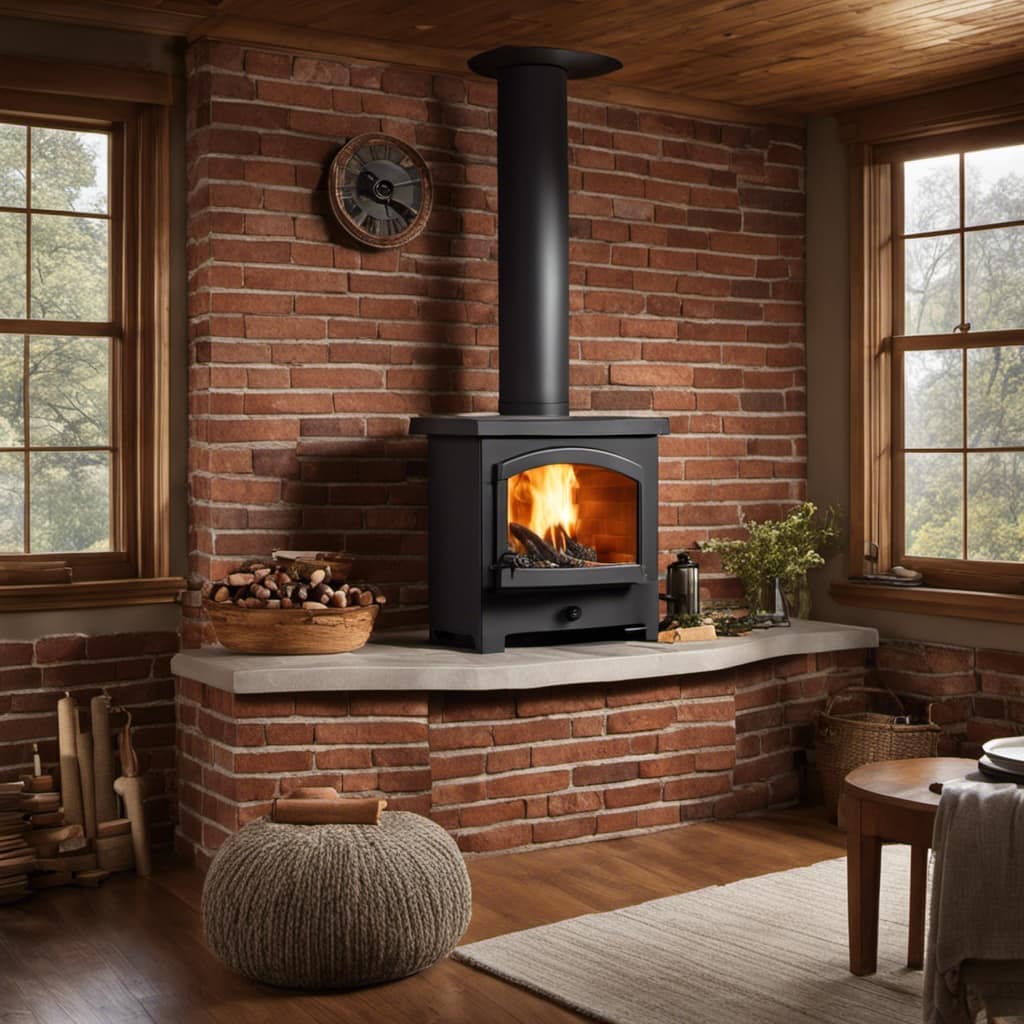
-
Properly load the wood stove: Make sure to arrange the firewood in a way that allows for good airflow. Start with smaller pieces at the bottom and gradually increase the size as you build the fire. This will ensure a steady and efficient burn.
-
Use the air vents effectively: Most wood stoves have air vents that control the amount of oxygen entering the firebox. Adjusting these vents can help regulate the burn rate and prevent smoke buildup. Open the vents fully when starting the fire and gradually close them as the fire becomes established.
-
Keep the stove clean: Regularly remove ash and debris from the firebox and clean the flue to ensure optimal airflow. A clean stove will allow for better combustion and reduce the risk of smoke buildup.
-
Use seasoned firewood: Seasoned firewood has a lower moisture content, which means it burns more efficiently and produces less smoke. Avoid burning green or wet wood, as it can lead to incomplete combustion and increased smoke production.
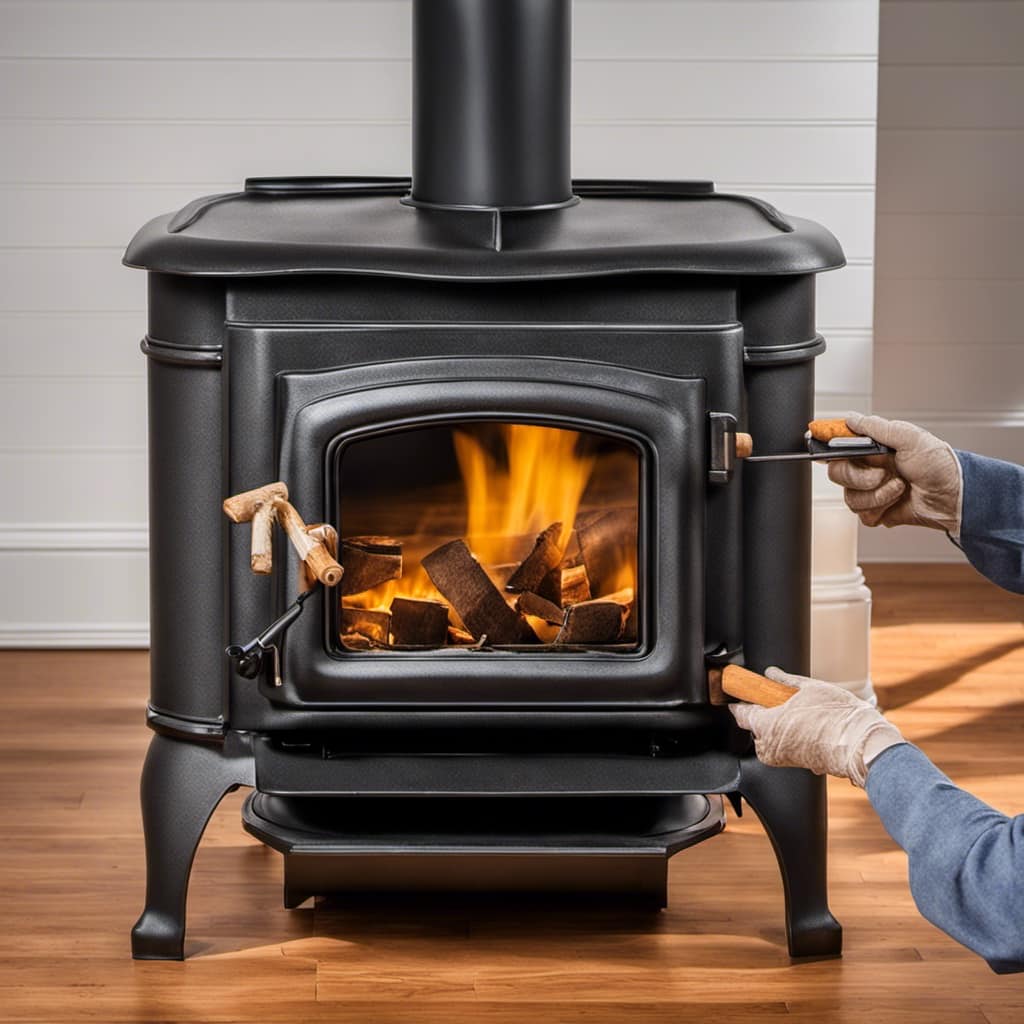
Managing Dampers and Air Controls
To ensure efficient burning in my wood stove, I adjust the dampers and air controls accordingly to regulate the flow of oxygen and prevent smoke buildup. Managing draft and minimizing heat loss are crucial in maintaining a steady and long-lasting fire. When it comes to dampers, there are typically two types: primary and secondary. The primary damper, located at the base of the stove, controls the amount of air entering the firebox. By opening it fully, I allow more oxygen to reach the fire, increasing its intensity. However, if I want to slow down the burn rate, I can partially close the primary damper to restrict the airflow. The secondary damper, found near the flue or chimney, helps control the draft. By adjusting this damper, I can regulate how much heat is lost up the chimney. By minimizing the heat loss, I can ensure that more heat is radiated into the room, making the wood stove more efficient.
| Dampers | Function | Adjustment |
|---|---|---|
| Primary | Controls airflow | Open fully for intense fire, partially close to slow burn rate |
| Secondary | Regulates draft | Adjust to minimize heat loss up the chimney |
Maintaining a Consistent Temperature
Maintaining a consistent temperature is crucial for optimal performance and efficiency of any heating system. To achieve this, it’s important to consider the fuel type used, as different fuels burn at different rates and produce varying amounts of heat.
Additionally, controlling the airflow is essential in regulating the combustion process and ensuring a steady temperature.
Lastly, proper insulation plays a vital role in heat retention, preventing energy loss and maintaining a consistent temperature throughout the space.
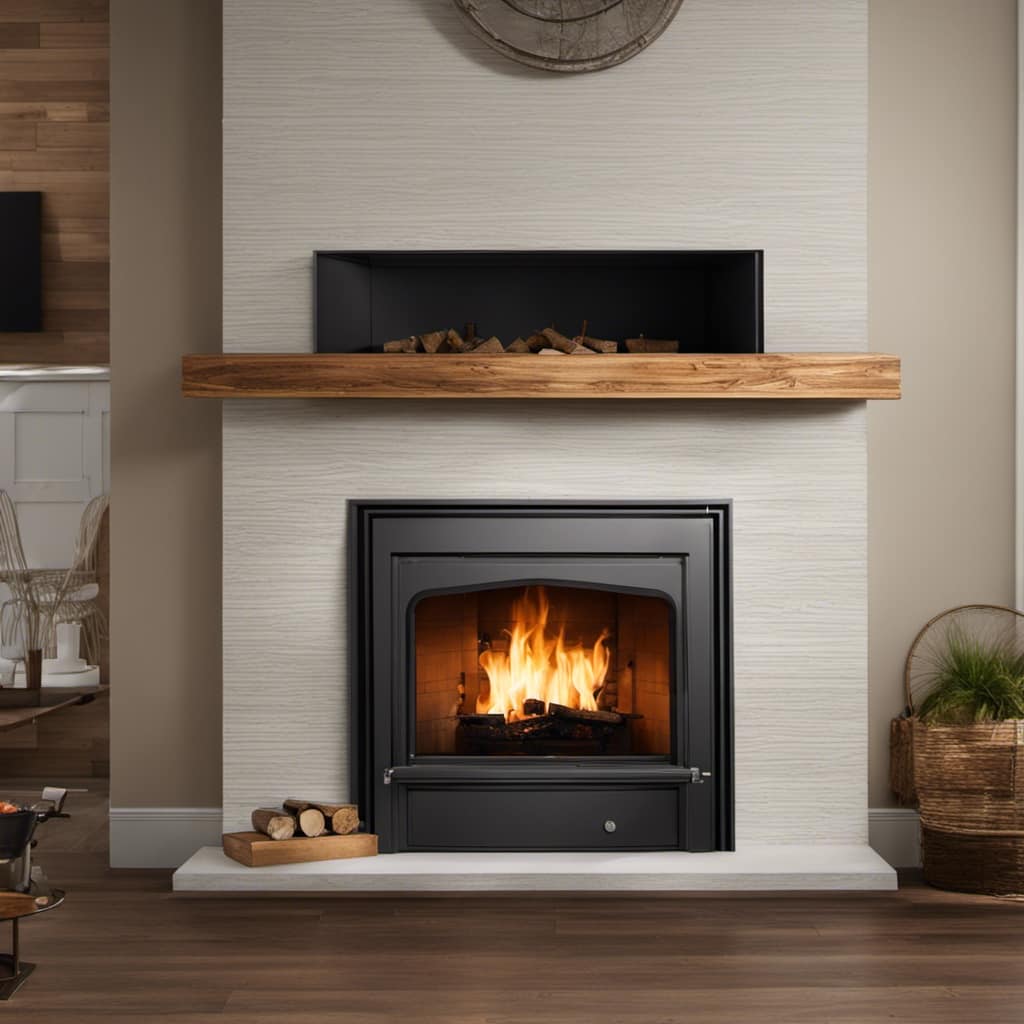
Fuel Type for Longevity
I find that using hardwoods like oak or maple provides longer burn times for my wood stove. Hardwoods are denser and have a higher energy content compared to softwoods like pine or fir. This means that they burn slower and release more heat, resulting in improved fuel efficiency.
However, there are alternative options that can also provide extended burn times:
-
Pellets: Made from compressed sawdust, pellets are highly efficient and produce minimal ash. They’re designed to burn cleanly and evenly, ensuring a consistent heat output throughout the night.
-
Coal: Although not commonly used, coal is a dense and slow-burning fuel option. It can generate a substantial amount of heat and maintain a fire for an extended period.
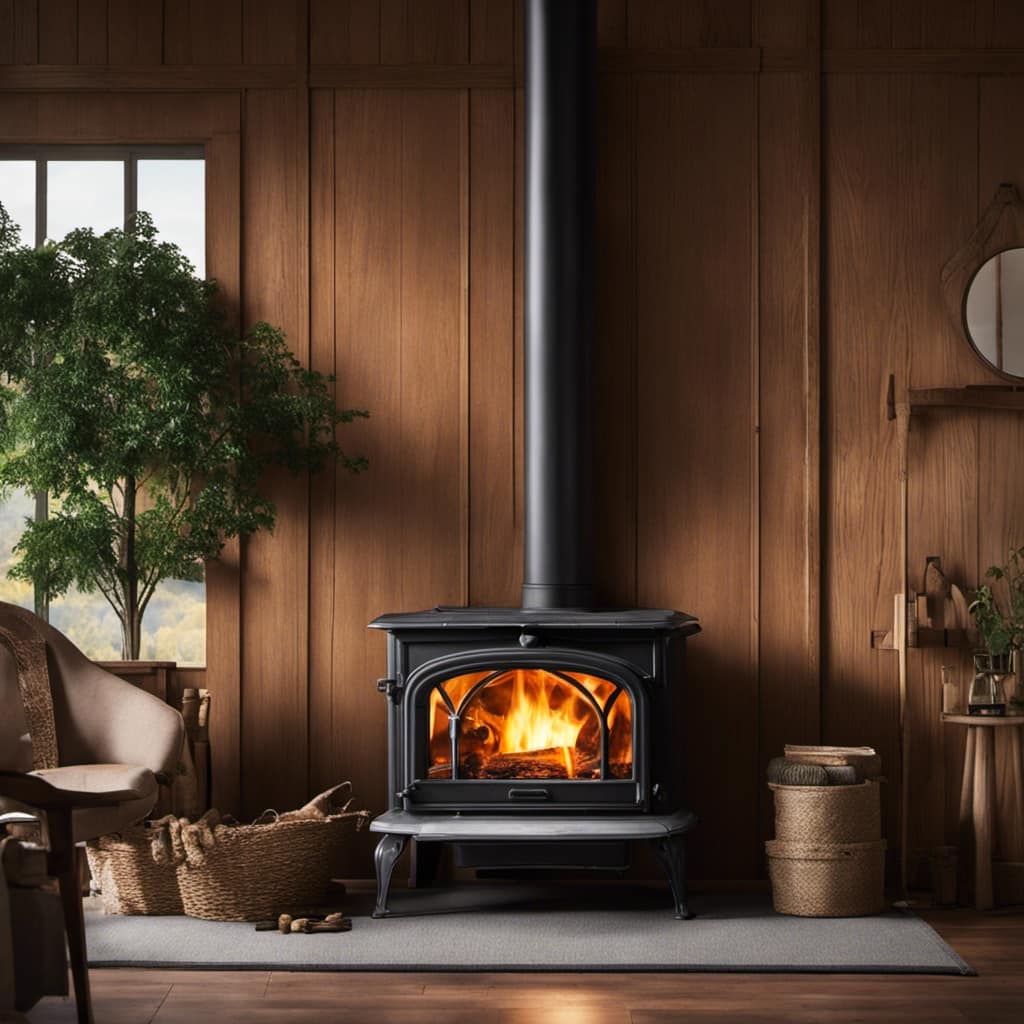
-
Dried fruit tree wood: This type of wood, like apple or cherry, is known for its high energy content. It burns slower than softwoods and can provide a longer-lasting fire.
-
Bricks or heat logs: These compressed fuel sources are specifically designed for long burn times. They’re made from a mixture of wood by-products and additives, resulting in a slow and sustained burn.
Airflow Control Techniques
When adjusting the damper and opening the stove door slightly, I can control the airflow to ensure a steady and efficient burn. The damper adjustment is a crucial step in regulating the intake of oxygen into the wood stove. By increasing the damper opening, more air is allowed in, resulting in a hotter, more intense fire.
Conversely, reducing the damper opening restricts the airflow, leading to a slower burn and less heat output. Flue pipe maintenance also plays a vital role in airflow control. Regular cleaning of the flue pipe prevents the buildup of creosote, a highly flammable substance that can obstruct the airflow.
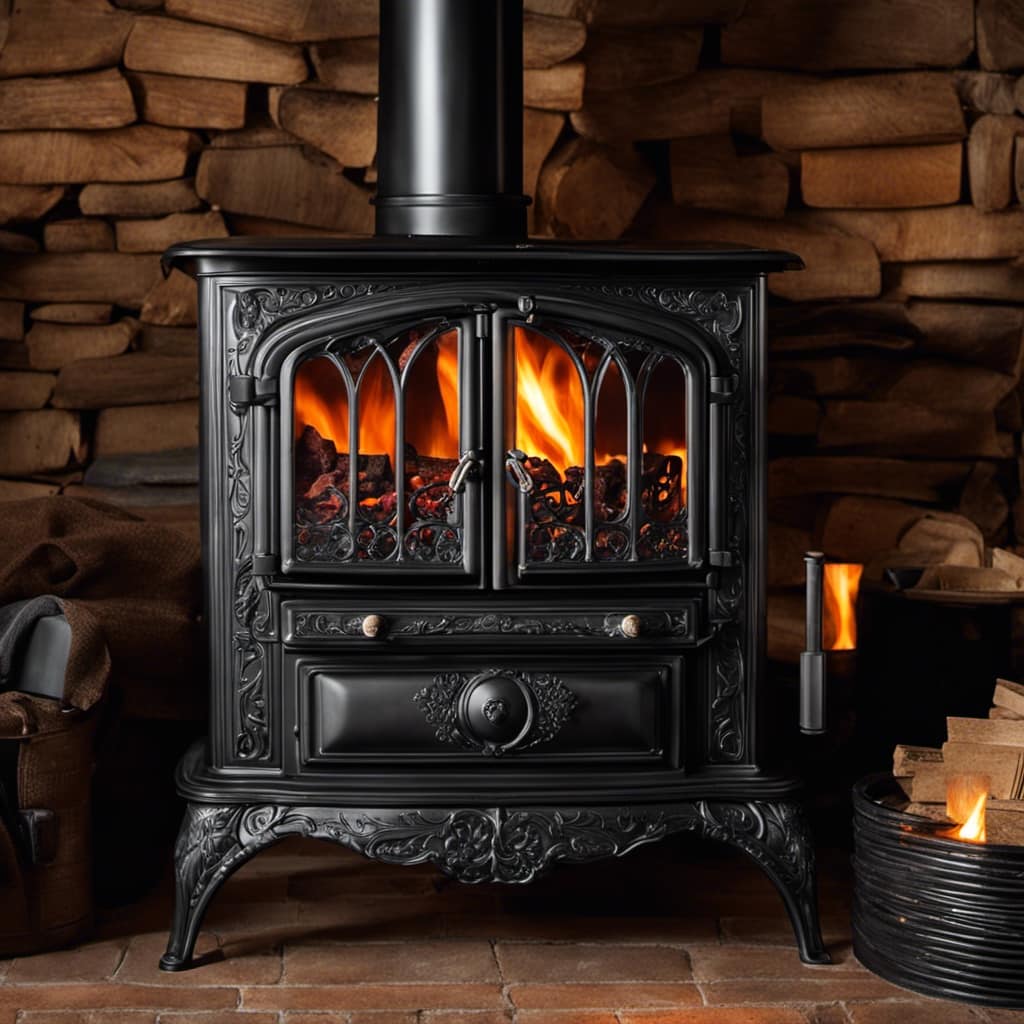
Clearing any blockages or debris from the flue pipe ensures a smooth and efficient passage of exhaust gases, promoting better combustion and a longer-lasting fire.
Insulation for Heat Retention
When it comes to keeping a wood stove burning all night, insulation plays a crucial role in heat retention.
Insulating your stove and the surrounding area can help prevent heat loss and maintain a comfortable temperature throughout the night. Heat resistant materials are essential for insulation, as they can withstand the high temperatures generated by the wood stove.
Additionally, an energy efficient design is important to maximize heat retention and minimize energy waste.
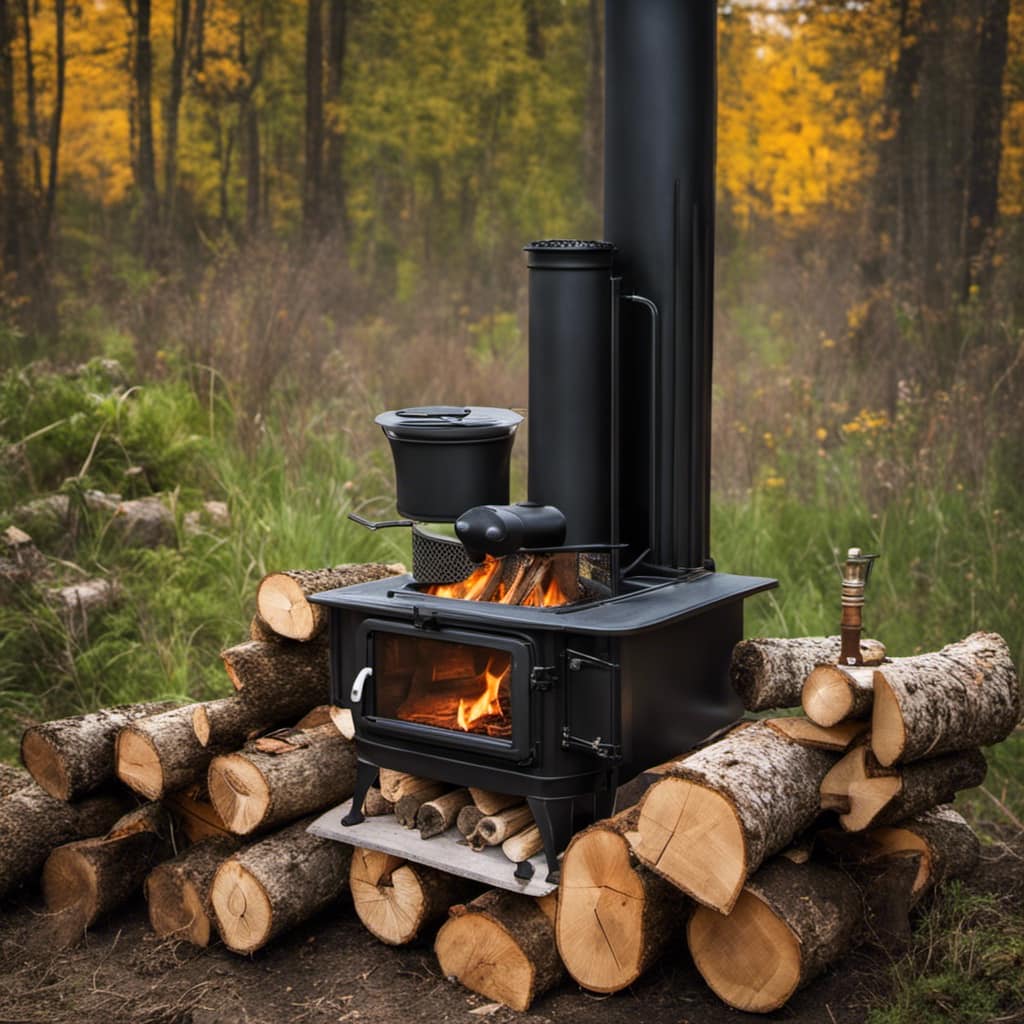
Here are four key factors to consider when insulating for heat retention:
- Using heat resistant materials such as fire bricks or ceramic fiber insulation
- Ensuring proper sealing around the stove and chimney to prevent air leaks
- Adding insulation to the walls and ceiling of the room to retain heat
- Installing a heat reflective barrier behind the stove to reflect heat back into the room.
Adding Fuel Throughout the Night
To keep the wood stove burning all night, I’ve found that adding fuel periodically throughout the night helps maintain a consistent heat. This technique maximizes burn time and ensures fuel efficiency. By adding fuel at regular intervals, you can keep the fire going without having to wake up in the middle of the night to tend to it.
To illustrate the importance of adding fuel throughout the night, I have created a table below that showcases the burn time and fuel efficiency of different wood types:
| Wood Type | Burn Time (hours) | Fuel Efficiency |
|---|---|---|
| Oak | 6-8 | High |
| Maple | 4-6 | Medium |
| Pine | 2-4 | Low |
| Birch | 3-5 | Medium |
| Ash | 5-7 | High |
As you can see, different wood types have varying burn times and fuel efficiencies. It is essential to choose the right type of wood for your wood stove to ensure a longer burn time and maximize fuel efficiency. By adding fuel throughout the night, you can extend the burn time and maintain a steady heat output, keeping your home warm and cozy all night long.
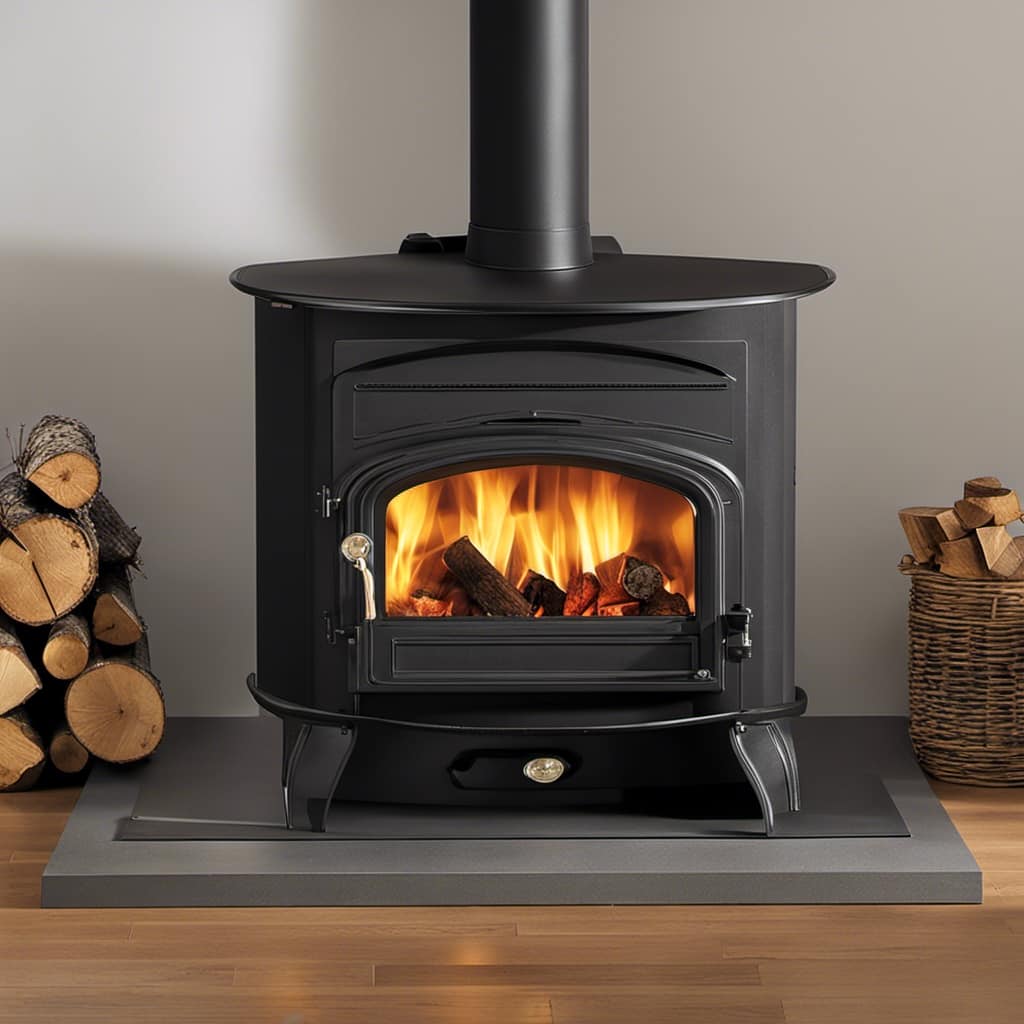
Cleaning and Inspecting the Wood Stove
Inspecting and cleaning the wood stove regularly ensures its optimal performance and reduces the risk of potential hazards. Proper maintenance is essential for keeping your wood stove in good working condition. Here are some cleaning techniques and safety measures to consider:
-
Remove ashes: Before cleaning the stove, make sure it has cooled down completely. Use a metal scoop or shovel to remove the ashes from the firebox. Dispose of the ashes in a metal container with a tight-fitting lid, and store it away from flammable materials.
-
Clean the glass: Over time, the glass on the stove door can become dirty and obstruct your view of the fire. Use a glass cleaner specifically designed for wood stoves to remove soot and grime. Avoid using abrasive materials that could scratch the glass.
-
Check for creosote buildup: Creosote is a highly flammable substance that can accumulate in the chimney and stovepipe. Inspect these areas regularly and remove any creosote buildup using a chimney brush. This will help prevent chimney fires.
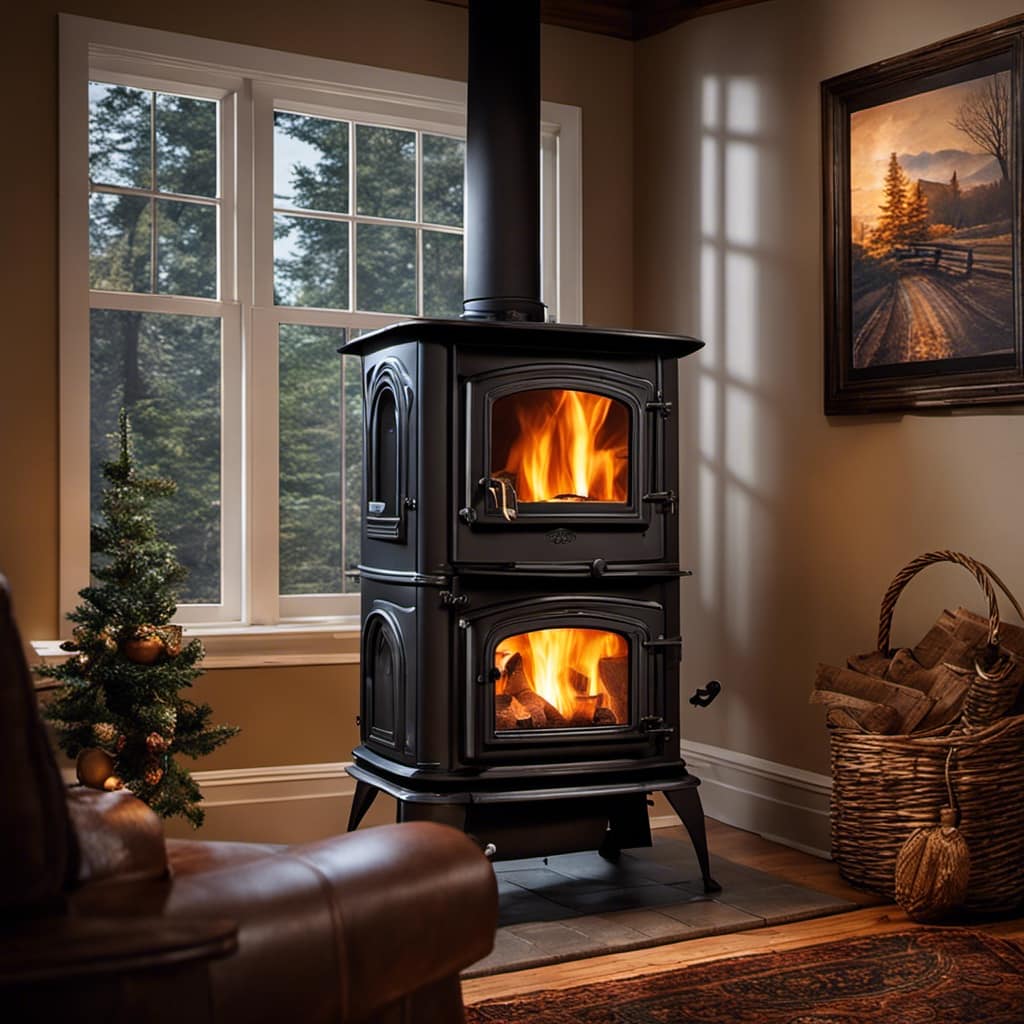
-
Inspect the gaskets: The gaskets on the stove door and ash pan should be in good condition to ensure a proper seal. Replace any worn or damaged gaskets to prevent air leaks.
Regular cleaning and inspection of your wood stove will help maintain its efficiency and reduce the risk of fire hazards.
Now, let’s move on to discussing safety precautions for overnight burning.
Safety Precautions for Overnight Burning
Now that we’ve discussed how to clean and inspect the wood stove, let’s move on to the important topic of safety precautions for overnight burning. Ensuring fire safety is crucial when operating a wood stove, especially when leaving it unattended for an extended period.

One major concern is the risk of carbon monoxide poisoning. To prevent carbon monoxide buildup, it’s essential to have a working carbon monoxide detector installed near the wood stove. This device will alert you if dangerous levels of carbon monoxide are detected in the air. Additionally, make sure the wood stove is properly ventilated to allow for the safe release of combustion gases.
When leaving the stove burning overnight, it’s crucial to use the right type of fuel. Only burn seasoned hardwoods that have been properly dried for at least six months. These woods produce less creosote buildup and burn more efficiently, reducing the risk of chimney fires.
Furthermore, it’s essential to maintain a clear area around the wood stove. Keep flammable materials, such as furniture, curtains, and rugs, at a safe distance. Install a fireproof hearth rug to prevent sparks from reaching the floor.
Frequently Asked Questions
Can I Use Any Type of Wood in My Wood Stove?
Yes, you can use different types of wood in your wood stove. The type of wood you choose will affect the burn time and heat output. Hardwoods like oak and maple burn slower and produce more heat, making them ideal for overnight burning.
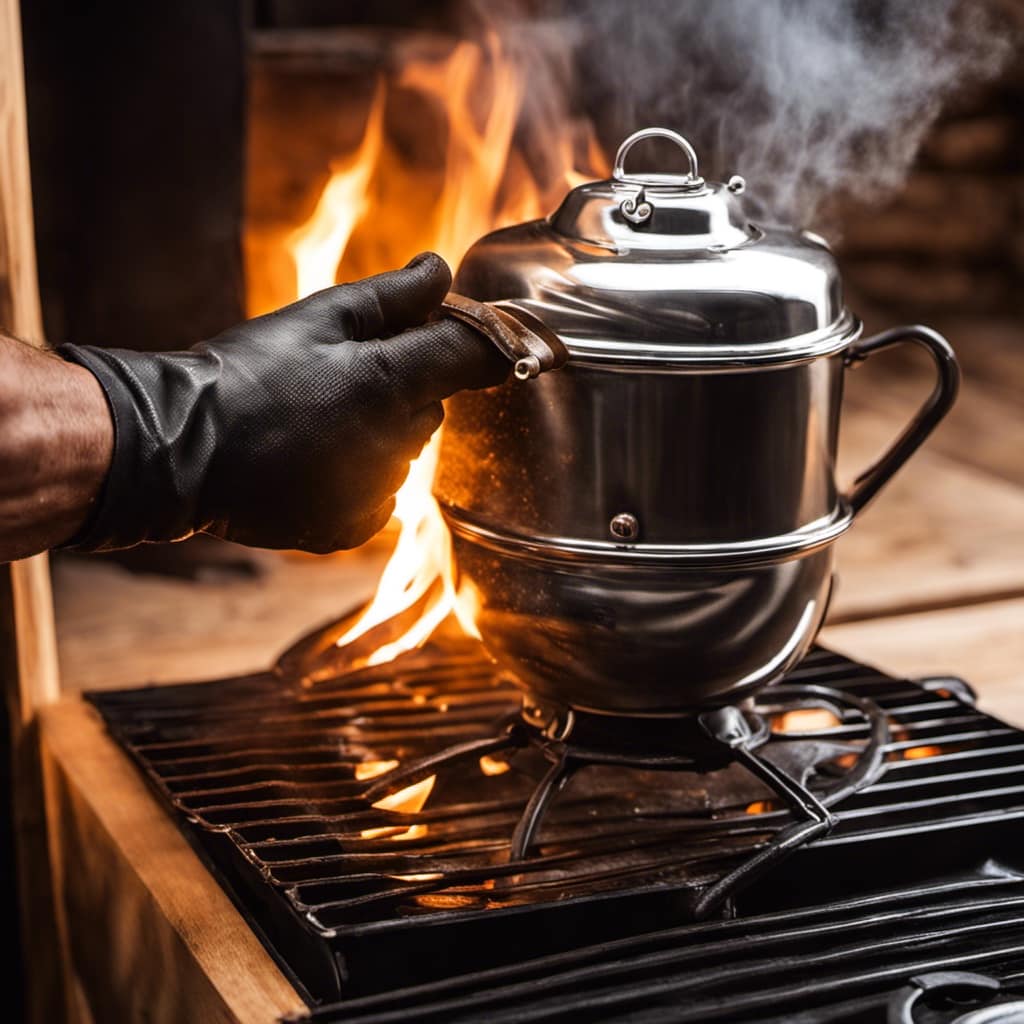
Softwoods like pine and fir burn faster and produce less heat, making them better for quick bursts of warmth. Remember to properly season and store your wood for optimal burning efficiency.
As for starting a fire, there are various methods, such as using kindling, newspaper, or fire starters.
How Often Should I Clean My Wood Stove?
Cleaning my wood stove is a crucial task that I can’t afford to neglect. Regular cleaning ensures optimal performance and prevents dangerous buildup of creosote. It’s recommended to clean the stove at least once a month during the burning season.
Neglecting this task can lead to decreased efficiency, increased risk of chimney fires, and even carbon monoxide poisoning. So, remember to take the time to properly maintain your wood stove for a safe and enjoyable fire experience.
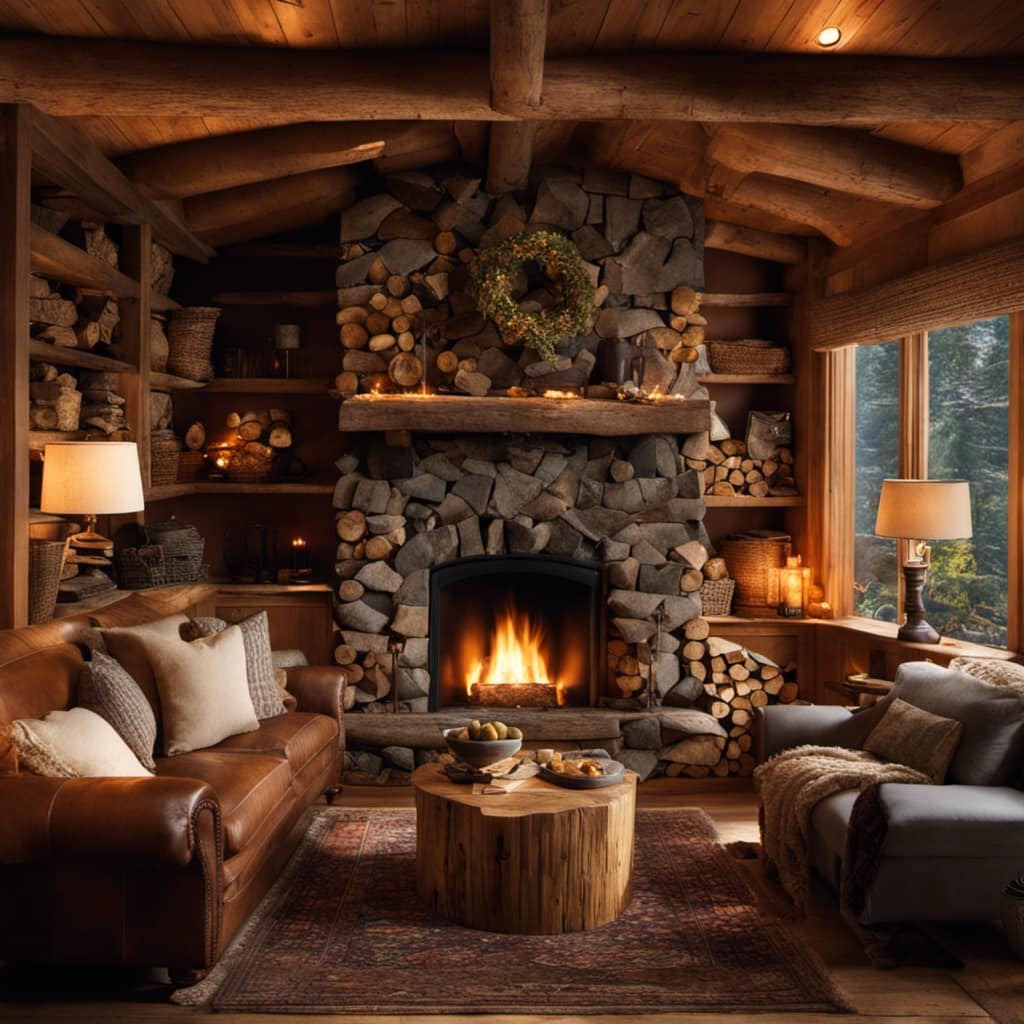
Is It Safe to Leave a Wood Stove Burning Overnight?
Leaving a wood stove burning overnight can be risky if proper safety precautions aren’t taken.
It’s important to ensure that the stove is in good condition and that there are no flammable materials nearby.
Additionally, using alternatives to leaving the stove burning all night, such as using fire bricks or installing a stove fan, can help maintain a consistent and safe heat source while reducing the risk of accidents.
Can I Use Newspaper or Cardboard to Start a Fire in My Wood Stove?
Yes, I can use newspaper or cardboard to start a fire in my wood stove. It’s a convenient and readily available alternative to traditional fire starters.
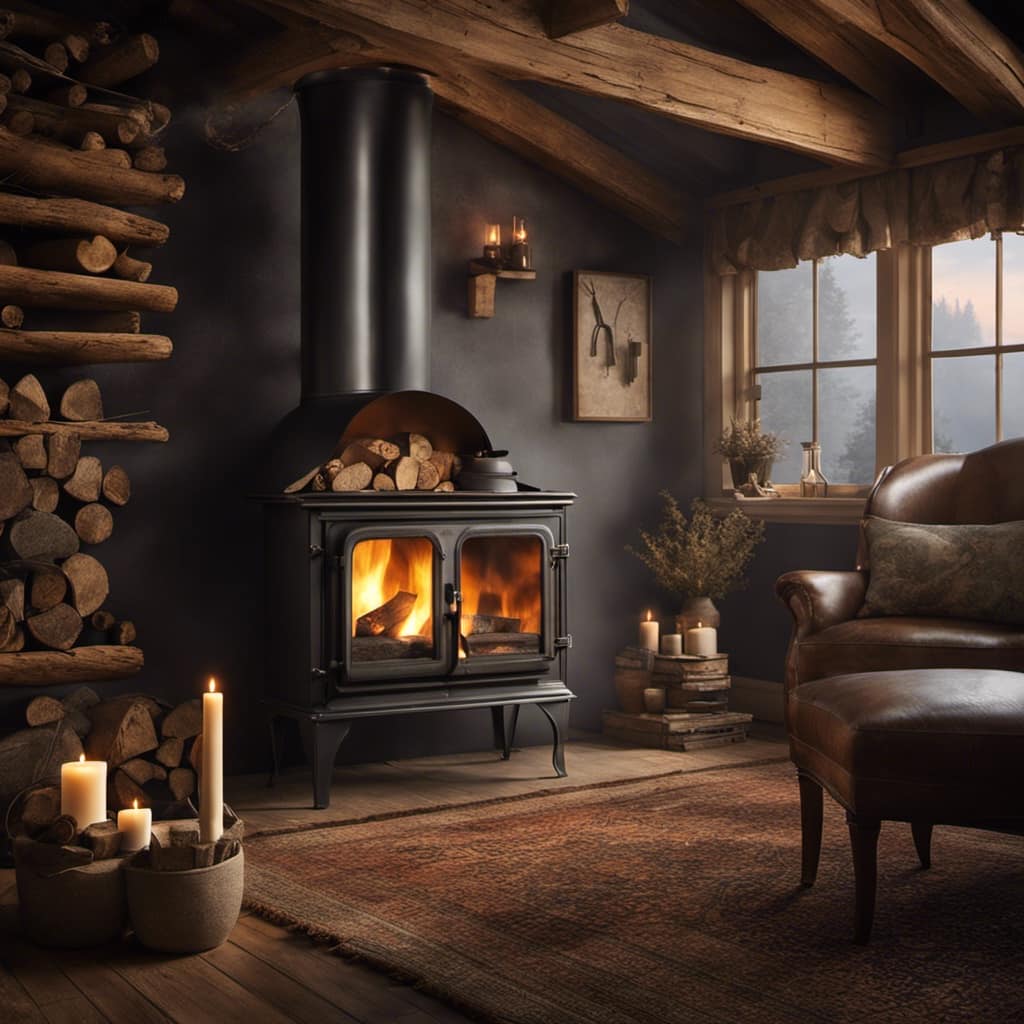
However, it’s important to ensure that the newspaper or cardboard is dry and free from any ink or chemicals that may produce harmful fumes.
Additionally, using the right type of wood, such as hardwoods like oak or maple, will help maintain a longer burn time and keep the wood stove burning all night.
What Should I Do if My Wood Stove Is Smoking Excessively?
When my wood stove is smoking excessively, I first check if the damper is open enough to allow proper airflow. If that’s not the issue, I inspect the chimney for any blockages or creosote buildup. Cleaning the chimney regularly can prevent excessive smoke.
Additionally, using properly seasoned firewood and avoiding damp or green wood can help. If the problem persists, consulting a professional chimney sweep or stove technician is recommended to troubleshoot and resolve the issue.
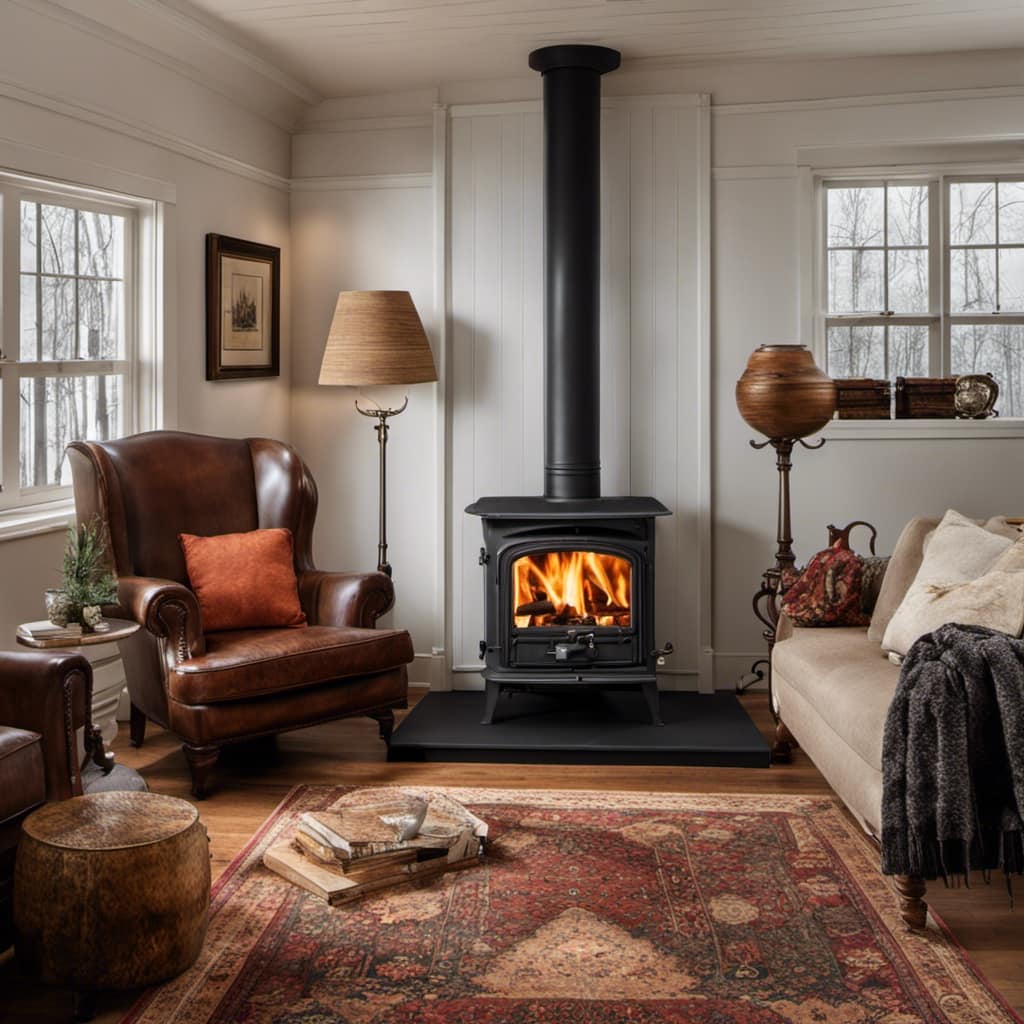
Conclusion
In conclusion, by following the proper steps and techniques, it’s possible to keep a wood stove burning all night.
From using properly seasoned firewood to maximizing airflow and managing dampers, these tips ensure efficient burning and a consistent temperature.
Regular cleaning and maintenance, along with practicing safety precautions, are also essential for overnight burning.
By implementing these strategies, you can enjoy a cozy and warm night’s sleep with your wood stove.
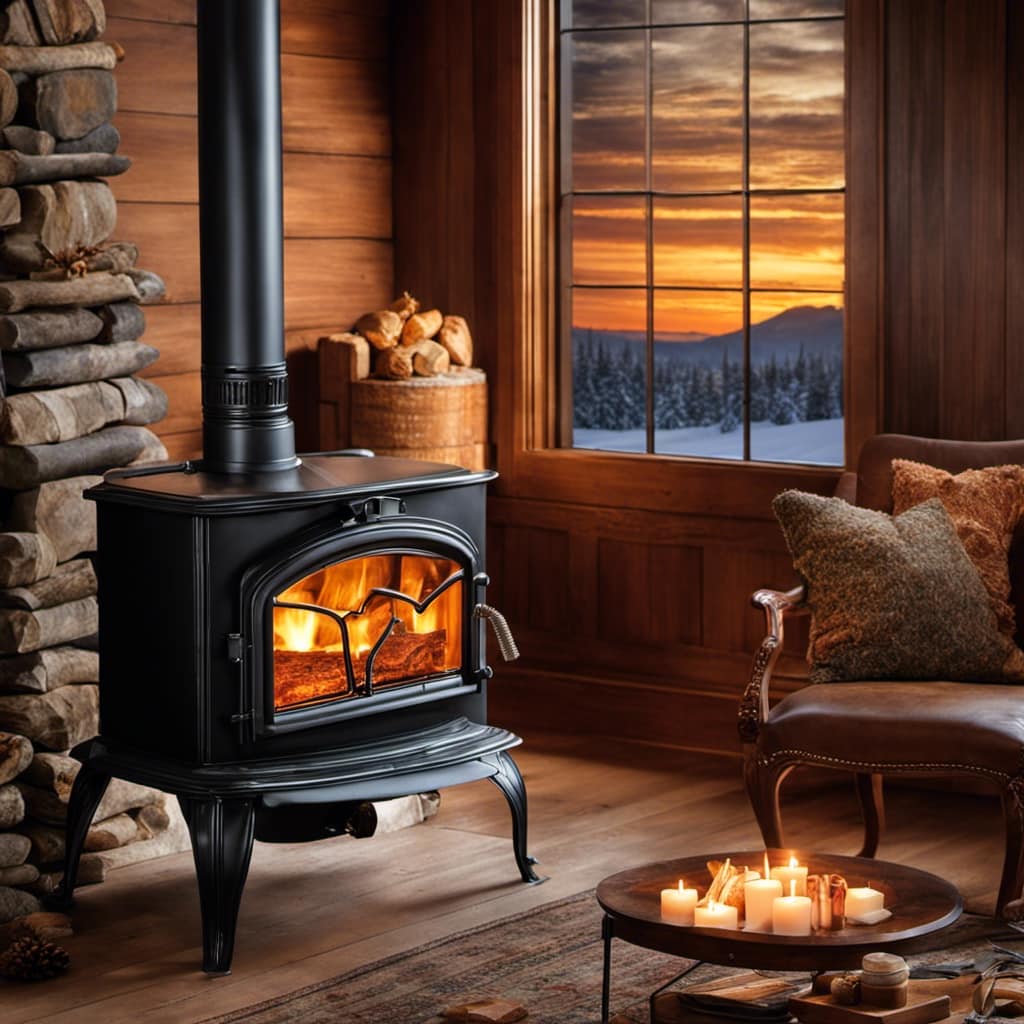
Growing up surrounded by the vast beauty of nature, Sierra was always drawn to the call of the wild. While others sought the comfort of the familiar, she ventured out, embracing the unpredictable and finding stories in the heartbeat of nature.
At the epicenter of every remarkable venture lies a dynamic team—a fusion of diverse talents, visions, and passions. The essence of Best Small Wood Stoves is crafted and refined by such a trio: Sierra, Logan, and Terra. Their collective expertise has transformed the platform into a leading authority on small wood stoves, radiating warmth and knowledge in equal measure.




